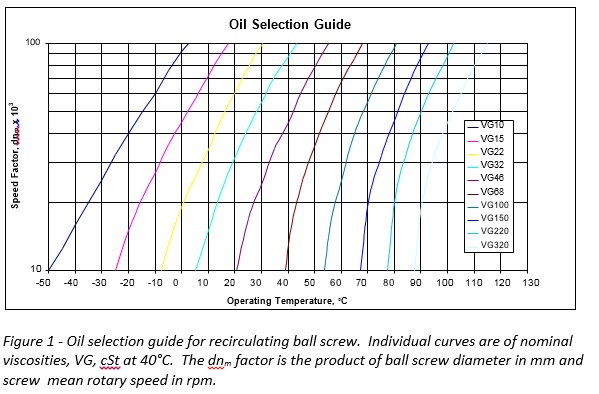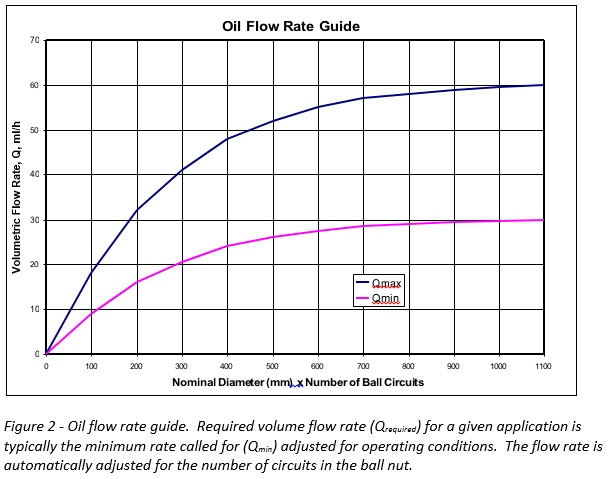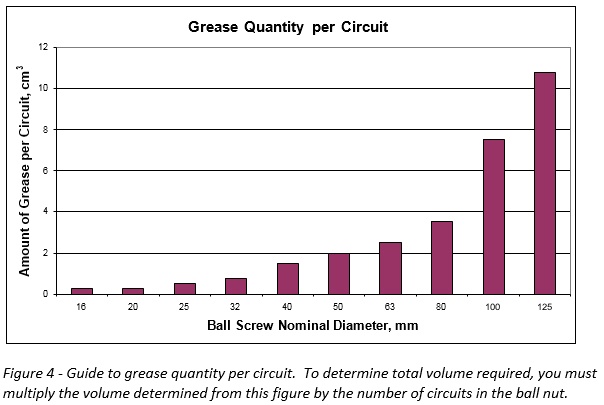Jeff Johnson, Product Engineer
Thomson Industries, Inc.
Wood Dale, IL 540-633-3549
www.thomsonlinear.com thomson@thomsonlinear.com
Many parameters must be considered when designing or selecting a ball screw assembly. Operating load, speed, accuracy, environment, and power requirements all play major roles in the design criteria. Whether the design engineer selects a rolled ball screw or a precision ground ball screw, the lubricant should also be carefully considered. A properly selected lubricant minimizes friction, reduces torque, increases the screw’s efficiency, and extends life. Lubricants maintain the low friction advantage of ball screw assemblies by minimizing the rolling resistance between balls and grooves and sliding friction between adjacent balls.
A ball screw assembly must be thoroughly cleaned to remove all contaminants before lubrication and re-lubrication. Contamination is a leading cause of premature failure of ball screws. Proper lubrication helps keep most contaminants out, which greatly reduces the damage foreign contaminants can cause. Rust preventative oil is typically used for shipping and storage of the components and should be wiped clean before application of the final lubrication selection.
There are several methods of delivering lubricant to a ball screw assembly, and several methods to retain the lubricant in the lubricated assembly. For example, a grease lubricated ball nut may have a grease fitting on the nut flange (if there is a flange) or on the nut body. The installation of wipers or seals is used to contain internal lubrication and repel external contamination. Oil systems require a pump, filtering system, and application method.
Lubricants are often taken for granted (hundreds of choices are available and many provide near identical performance, contact a lubrication expert or ball screw manufacturer to narrow the selection), but the right choice for each application ensures a ball screw that performs properly for its calculated life. Both oil and grease provide corrosion protection, but lubricant choice depends on evaluation of the advantages and disadvantages of each in the given application.
Oil can be applied at a controlled flow rate directly to the point of need, and it will clean out moisture and other contaminants as it runs through the ball nut. It can also provide cooling. Oil disadvantages you must consider include:
A. Possibility of excess oil contaminating the process, such as mixing with the cutting fluid in a machining application.
B. Cost of a pump and metering system to apply oil properly.
Grease is less expensive than oil to apply and requires less frequent application, and it does not contaminate process fluids. On the other hand:
- It is not possible to keep all the grease within the ball nut, it has a tendency to build up at the ends of ball nut travel, where it accumulates chips and abrasive particles.
- Incompatibility of old grease with re-lubrication grease can create a problem. Be sure to check compatibility.
Oil Lubrication
Operating temperature, load, and speed determine the oil viscosity and application rate needed for each installation. If the oil is too viscous or too much oil is being applied then heat may be generated. If the oil viscosity is too low or too little is being applied then parts may not be coated adequately; friction and wear may result. The selection of the oil lubrication will directly influence the temperature rise of the ball screw and the life of the assembly.
The following guidelines are appropriate for most applications, but if extremes in temperature, load, or speed are involved, it is advisable to consult with a lubrication specialist. Metric measurements are used in these guidelines, if inch size ball screws are used, conversion to metric dimensions is required.
The recommended nominal viscosity of the oil at 40°C is based on the mean speed of the ball screw, its diameter, and the temperature at which the ball nut is likely to stabilize. Viscosity is expressed in centistokes (1 cSt = 1mm2/sec). Various grades have been selected for standardization and are used in the oil selection guide of Figure 1. For example, VG32 is oil with nominal viscosity of 32 cSt at 40°C.

![]()

To determine the nominal viscosity of the oil for an application, the mean speed of rotation of the ball screw needs to be established and from it, the dnm factor can be calculated. The temperature at which the ball nut is likely to stabilize must also be determined.
Mean speed of rotation accounts for the ball screw’s duty cycle:
nm = n1 (q1 /100) + n2 (q2 /100) + n3 (q3 /100) + ...
Where:
nm = mean speed, rpm
n1,2,3… = speed for time q1,2,3…, rpm
q1,2,3… = time at speed n1,2,3…, % of total
For typical applications, nm ranges from 200 to 500 rpm. The dnm factor is given by:
dnm = (d )(nm )
Where:
d = ball screw nominal diameter, mm
Typical values of dnm are in the range of 5,000 to 25,000. Values of dn up to 160,000, where n is the maximum speed of rotation, are becoming more common, and in such cases the lower viscosity should be used in the oil selection guide indicates a grade midway between two adjacent viscosity curves, such as VG32 and VG46.
Ball nut operating temperature should be about 20°C, but this is seldom the case in real operation. Usually, a ball nut stabilizes a few degrees above screw shaft operating temperature. If the nut temperature cannot be measured, assume it to be 30°C for your initial selection of oil viscosity.
Required oil flow rate is a function of:
- Number of ball circuits
- Ball screw orientation
- Operating environment
- Load
- Speed
- Judgments based on knowledge of the application
The oil flow rate guide of Figure 2 helps determine oil application requirements. It shows a range of flow rates in ml/hr for various values of the product of ball screw nominal diameter (mm) and number of ball nut circuits. For example, a 25mm diameter ball nut with 6 circuits gives a horizontal axis value of 150, this equates to a flow rate ranging from a minimum (Qmin) to 13 ml/hr to a maximum (Qmax) of 26 ml/hr.

The rate you should select within this range depends on operating conditions:
- Orientation - If the ball screw is horizontal add nothing to Qmin, if in the vertical plane then add 25%
- Environment - If the application is clean and dry add nothing to Qmin, if the environmental conditions are not favourable then add 25%
- Severe running conditions - If the screw is not subject to high loads or speeds add nothing to Qmin, if the operating conditions are high then add 50%
For example, the 25mm diameter ball screw with 6 circuit ball nut is used in a vertical application (add 25% to the minimum of 13 ml/hr); it is clean and dry (add 0%); and it is heavily loaded (add another 50%).
Qrequired = 13+(13*.25)+(13*0)+(13*.50) = 22.75 ml/hr
It is advisable to supply a small amount of oil at regular intervals in cases where heavy loads are anticipated in this example, apply oil about every minute;
(22.75 ml/hr)(1 hr/60 min) = .38 ml/min
Without the heavy load, application every 5 min would be adequate.
Experience has shown that a slightly thinner oil, than indicated, can be used without difficulty. However, if the application calls for, say, a VG46 oil, but a VG10 is all that is available, the oil delivery system would have to be revised to replace spot delivery with continuous flow of the lighter oil.
Grease Lubrication
Ball screws must be lubricated to operate properly to achieve the rated life. Greases can be applied directly to the screw threads near the root of the ball track or pumped directly into the ball nut if lube holes are provided. It is recommended that wipers be utilized to contain the lubricant within the body of the ball nut.
Speeds that are high for ball screws are not a problem for grease, so speed is not a criterion for selection. For example, grease is the accepted lubricant for machine tool spindles with dn (bearing bore, mm x rpm) values as high as 1,000,000. For ball screws, dn values rarely exceed 100,000.
Synthetic greases offer many performance advantages over mineral-based lubricants. Synthetic lubricants function over wider temperature ranges; they offer greater stability and they retain the viscosity needed to provide an adequate film thickness through a specified range of operating temperatures, speeds, and loads.
Special additives can improve the grease’s ability to resist contaminants and reduce wear in the presence of load and vibration. Other additives can also reduce friction, decrease noise, and increase load capacity. Do not use greases with graphite or molybdenum disulfide as these provide too low friction which promotes ball skid and interferes with the rolling process of the ball bearings.
Specialty greases are also available which include but are not limited to vacuum grade, food grade, clean room, and extreme temperatures. Match the grease selection to the application environment and then select based on performance requirements.
Precision ground ball screws, where precise motion and smooth, quiet operation are desired, can take advantage of filtration technology. Additional filtration of grease and oil results in lubricants with unsurpassed cleanliness. Filtration also improves the homogeneity of the thickening agent and removes virtually all particulate matter.
One problem with grease: It tends to be fed out of the nut and onto the ball screw, accumulating at the extremities of travel where it collects contaminants. Thus you must replenish it regularly. Excess grease must be removed leaving only a thin film of lubrication on the screw shaft at all times.
Grease is a complex subject. Greases consist of mineral or synthetic oil, additives, and a thickening agent such as lithium, bentonite, aluminum, and barium complexes. NLGI Grade is a widely used classification for lubricating greases. It was established by the National Lubricating Grease Institute. Greases are classified in one of nine grades based on their consistency.
NLGI Grade alone is not sufficient for specifying the grease for a particular application but it is a useful qualitative measure. While the science of tribology is still developing, NLGI Grade, in combination with other test-based properties is the only method for determining the potential suitability of various greases for a specific application.
The nine grades are defined by a range of worked penetration test results. The following Figure shows the NLGI grades and the worked penetration ranges:
|
NLGI Grade |
Worked penetration after 60 Strokes at 25 °C (0.1 mm) |
Appearance |
|
000 |
445-475 |
fluid |
|
00 |
400-430 |
fluid |
|
0 |
355-385 |
very soft |
|
1 |
310-340 |
soft |
|
2 |
265-295 |
moderately soft |
|
3 |
220-250 |
semi-fluid |
|
4 |
175-205 |
semi-hard |
|
5 |
130-160 |
hard |
|
6 |
85-115 |
very hard |
Figure 3 - NLGI Grade
NLGI Grades 000 to 1 are used in application requiring low viscous friction. Grades 0, 1 and 2 are used in highly loaded gearing. Grades 1 through 4 are often used in rolling contact bearings where Grade 2 is the most common.
Grease Consistency — Lower numbers are softer and flow better, while higher numbers are firmer, tend to stay in place, and are a good choice when leakage is a concern. The table above shows the most common NLGI grades.
The guide to grease quantity per circuit, Figure 4, shows the recommended quantity in cm3 per ball circuit in the nut as a function of nominal ball screw diameter. For example, a 25mm diameter ball screw with 6 circuits requires 0.4 cm3/circuit, or 2.4 cm3 of grease total.

As a rule of thumb, replenish grease at least every 600-800 hours. However, because conditions vary so widely, the presence of lubricant should be confirmed by periodic inspection, and readjusted if required. For extreme conditions, such as dn values above 50,000, consult a lubrication expert or ball screw manufacturer.
All ball screw assemblies should be run smoothly throughout the entire stroke. If the torque is not uniform over the entire stroke:
- Visually inspect the screw shaft for accumulations of foreign contaminants.
- Using cleaning fluid or solvent, remove dirt from the ball grooves. Be sure to flush the ball nut assembly thoroughly.
- Cycle the ball nut along the screw shaft several times. Wipe with a dry, lint-free cloth and lubricate immediately.
Grease Recommendations
The following recommendations are not a complete list. Contact your lubrication provider or ball screw manufacturer for recommendations based on environment and performance.
|
Light Duty Grease |
Temp (°C) |
Notes |
|
Nye Rheolube 362F |
-54 to 125 |
Low viscosity, lithium, synthetic, PTFE fortified |
|
Nye NyoGel 744 |
-40 to 125 |
PTFE fortified, synthetic, w/ tackifier |
|
Nye UniFlor 8512 |
-50 to 225 |
Chemically resistant, fluorinated, wide temp |
|
Timkin All Purpose |
|
|
|
Heavy Duty Grease |
Temp (°C) |
Notes |
|
Thomson TriGel-450R |
125 Max |
|
|
Nye Rheolube 380 |
-50 to 130 |
EP fortified, lithium, synthetic and ester |
|
Nye Rheolube 363 |
-54 to 125 |
Multi-purpose synthetic |
|
Nye NyoGel 744F-MS |
-40 to 125 |
Synthetic, molybdenum disulfide fortified |
|
Nye UniFlor 8511R |
-50 to 225 |
Chemically resistant, rust inhibited, wide temp. |
|
Shell Albida EP |
150 Max |
|
|
Super Lube EP |
-40 to 250 |
|
|
Mobil Mobilth SHC 220 |
-40 to 150 |
Synthetic base |
|
Pennzoil Pennlith Ultra EP |
|
Washout resistant |
|
Timkin Synthetic |
|
|
|
High Speed Grease |
Temp (°C) |
Notes |
|
Nye Rheolube 733F, Ultra |
-54 to 125 |
EP & PTFE fortified, low temp & low noise |
|
Nye Instrument 732C |
-54 to 150 |
Ester based, wide temp |
|
Nye Rheolube 374C |
-40 to 150 |
Lithium, synthetic |
|
Kluber IsoFlex NBU15 |
|
|
|
Shell Alvania RL |
130 Max |
Multi-purpose |
|
Mobil Mobilth SHC 100 |
-40 to 150 |
Synthetic base |
|
Timkin Ultra High Speed |
|
|
|
Timkin Ball Bearing |
|
|
|
Vacuum Grade Grease |
Temp (°C) |
Notes |
|
Thomson TriGel 1200SC |
250 Max |
Light to moderate load |
|
Thomson TriGel 1800RC |
125 Max |
Moderate load |
|
Nye NyeTorr 5200 |
-45 to 125 |
Ultrafiltered, PTFE thickened, low noise |
|
Nye NyeTorr 5300 |
-65 to 250 |
Ultrafiltered, chemically resistant, wide temp |
|
Dupont Krytox LVP |
-15 to 300 |
Wide temp, chemically inert |
|
Super Lube Vacuum |
|
|
|
Food Grade Grease |
Temp (°C) |
Notes |
|
Dupont Krytox FG30 |
-40 to 150 |
Inert |
|
Dupont Krytox FG32 |
-60 to 260 |
High Temperature |
|
Super Lube H-1 |
-40 to 230 |
USDA registered for incidental food contact |
|
Timkin Food Safe |
|
|
Conclusion
BALL SCREWS SHOULD NEVER BE RUN WITHOUT LUBRICATION!
The right oil or grease lubrication for ball screw assemblies reduces unscheduled downtime for repair by ensuring that the assemblies deliver their expected service life.


